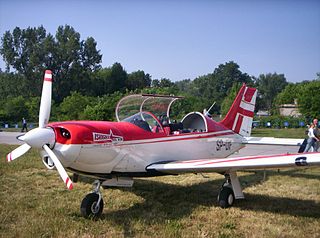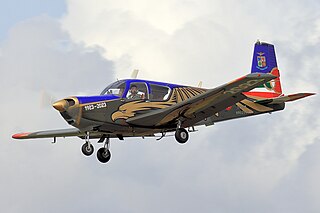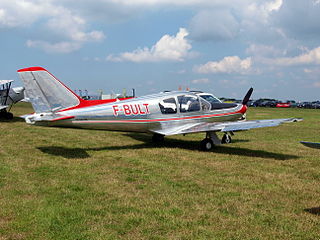
The Piper PA-24 Comanche is an American single-engine, low-wing, all-metal monoplane of semimonocoque construction with tricycle retractable landing gear and four or six seats. The Comanche was designed and built by Piper Aircraft and first flew on May 24, 1956. Together with the PA-30 and PA-39 Twin Comanches, it made up the core of Piper's lineup until 1972, when the production lines for both aircraft were destroyed in the 1972 Lock Haven flood.

The Pitts Special is a series of light aerobatic biplanes designed by Curtis Pitts. It has accumulated many competition wins since its first flight in 1944. The Pitts biplanes dominated world aerobatic competition in the 1960s and 1970s and, even today, remain potent competition aircraft in the lower categories.

The PA-25 Pawnee is an agricultural aircraft produced by Piper Aircraft between 1959 and 1981. It remains a widely used aircraft in agricultural spraying and is also used as a tow plane, or tug, for launching gliders or for towing banners. In 1988, the design rights and support responsibility were sold to Latino Americana de Aviación of Argentina.

The Citabria is a light single-engine, two-seat, fixed conventional gear airplane which entered production in the United States in 1964. Designed for flight training, utility and personal use, it is capable of sustaining aerobatic stresses from +5g to -2g. Its name, "airbatic" backwards, reflects this.

The Zlin Z-50 is an aerobatic sports airplane built by the Czechoslovakian company Zlin Aircraft.

PZL M26 Iskierka or M26 Airwolf is a Polish trainer and aerobatic aircraft, designed at WSK PZL-Mielec.

The Fuji FA-200 Aero Subaru is a single-engine piston-powered monoplane built by Fuji Heavy Industries of Japan.

The SIAI-Marchetti S.205 is an Italian four-seat, single-engine, light airplane, manufactured by SIAI-Marchetti. The S.205 made its maiden flight in 1965. The Italian Air Force employs a version called S.208.

The Lake Buccaneer is an American four-seat, light amphibious aircraft derived from the Colonial C-2 Skimmer, itself a development of the three-seat Colonial C-1 Skimmer.

The Procaer F.15 Picchio is an Italian-designed light utility aircraft built by Procaer.

The Wassmer WA-51 Pacific is a French four-seat cabin monoplane designed and built by Société Wassmer. Different-powered variants include the Wassmer WA-52 Europa and the Wassmer WA-54 Atlantic. It was the world's first composite material-built aircraft.

The Malmö MFI-10 Vipan was a four-seat light utility monoplane designed and built in Sweden by Malmö Flygindustri. Only three aircraft were built and the type did not enter quantity production.

The Wassmer WA-40 Super 4 Sancy is a French single-engined light aircraft of the 1960s and 70s. A single-engined low-winged monoplane with retractable nosewheel undercarriage, variants include the more powerful WA 4/21 Prestige and the WA-41 Baladou with a fixed undercarriage.

The Ruschmeyer R 90 is a four-seat light aircraft designed and produced in Germany in the late 1980s and early 1990s.
The Hongdu N-5,, originally known as the Nanchang N-5, is a Chinese agricultural aircraft. First flown in 1989, and entering into production in 1992, the N-5 is a single-engined low-wing monoplane, and is available in versions powered by a piston engine or a turboprop.

The Robin R 3000 is a French single-engined light aircraft designed and built by Avions Robin, which entered production in the 1980s.

The Gazuit-Valladeau GV-103 Gazelle was a French-built light two- to four-seat training, aerobatic and touring aircraft of the late 1960s.

The Ameur Altania was a single-engine light aircraft of pusher configuration with side-by-side seats for two and a V-tail, designed in France in the 1990s. Several prototypes were built and flown, including a 15 m span motorglider version; the final prototype was constructed from carbon composites rather than glass fibre. Another version, the UCA Carbon Bird has been built by Universal Composite Aviation after the bankruptcy of Ameur Aviation.

The Speedtwin E2E Comet 1, originally named the Phillips ST1 Speedtwin, is a two-seat, twin engined aircraft designed in the UK to be capable of aerobatics and the only civil twin certified for intentional spinning. After a long development time, just two have been built.

The ENAER ECH-02 Ñamcú was a single-engine, two-seat, light aircraft, designed and built by the Chilean manufacturer ENAER. A first prototype flew in 1989, and while the joint venture company Euro-ENAER was set up to build the aircraft in the Netherlands as the Euro-Enaer Eaglet, these plans failed when Euro-ENAER went bankrupt in 2002.



















